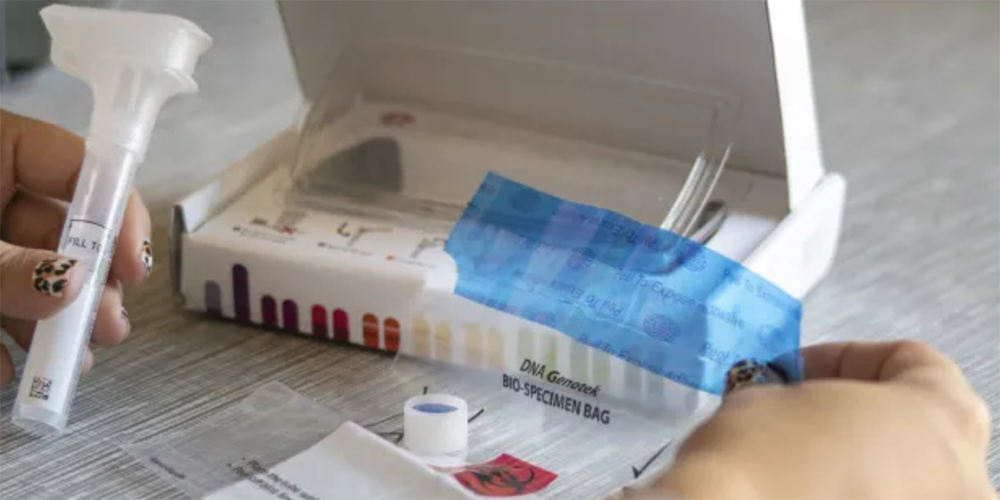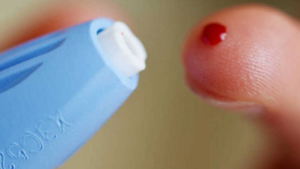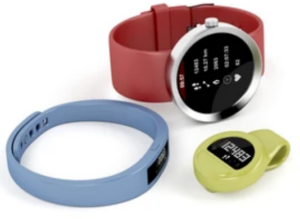Testing, testing
“Step right up folks,” crows the carnival barker lurking inside our smart devices.
“Now you can learn about your health from the comfort of your home without ever needing to see a doctor! Just send in a urine, saliva, or blood sample, and you’re on the path to knowing more about your health needs, your health outlook, and how to treat all of the hidden health issues you didn’t know you had. Could you have Lyme disease? Perhaps it’s HIV. Do your genes make you more likely to get late-onset Alzheimer’s? And hey, how’s your vitamin D? Cholesterol? Estrogen levels?”
DIY testing
With every passing day, more and more home-medical tests come online, all promising to look inside your body using advanced imaging and diagnostic techniques. Today, low-cost devices enclosed inside a watch can view blood flow and analyze internal cellular function using light sensors on the skin. There are devices that may predict the onset and severity of chronic diseases, and devices that promise to ward off diseases once considered fatal. The latest craze is the at-home genetic test that uses a small amount of blood or saliva to pinpoint your ancestry in order to predict potential diseases linked to your genetic makeup.
At-home medical testing represents a $25-billion market, and classifies into three main types:
- Self-tests: Allows the entire process to be conducted at home including sample collection and results.
- Self-collection tests: Involves taking a sample at home and sending it to a laboratory for analysis. Results are mailed back to you.
- Tests ordered from home: Sample collection and analyses are done in a laboratory, but a specially designed website streamlines scheduling and payment.
These DIY tests can range in cost from about $10 for strips to upwards of $200 for genetic testing. More than 50 single or in-combination medical tests can be done in the privacy of your home.
| At-home medical tests can be used to identify the following conditions | |||
|---|---|---|---|
| Food allergies | C-reactive protein | Celiac disease | Cholesterol |
| Chlamydia | Colon cancer | Covid-19 | Diabetes |
| DNA-ancestry | DNA-rare diseases | Different drugs | Seasonal flu |
| Genital/oral herpes | Hepatitis B & C | HIV | HPV |
| Kidney disease | Liver/colon function | Lyme disease | STD |
| Stress | Sleep apnea | Strep throat | Syphilis |
| Thyroid disorders | Trichomoniasis | Urinary tract infection | Vitamin deficiencies |
| Yeast infection | |||
DIY test uses
- Screening: Looking for health problems before any symptoms occur, i.e., testing for sexually transmitted diseases (STDs)
- Diagnosis: Identifying health problems after symptoms have started, i.e., COVID-19 testing
- Monitoring: Tracking health changes over time or in response to treatment, i.e., blood-sugar monitoring
- Disease risk assessment: DNA-mutations testing that can indicate cancer risk or ancestral history of disease
- Wellness optimization: Testing to help understand one or more physical, mental, or emotional wellness problems, i.e., hormone or nutrient-levels testing
Benefits and downsides
Certainly, the convenience of at-home testing can’t be denied; to be informed and active in one’s own healthcare is a positive thing.But there are downsides to DIY-home medical testing. A lack of medical guidance further complicates the already complex process of test interpretion. Often, understanding test results requires the ability to give “overall health context,” which most individuals are not able to provide for themselves. Researching health conditions online can be confusing and often misleading. It’s challenging to read and “decode” scholarly, medical research, so patients rely on testimonials and corporate-sponsored stories instead. This may result in misunderstandings and erroneous conclusions. In some cases, the patient decides to take unproven, unnecesary, or dangerous substances.
For the most part, problems with DIY medical tests center on the following issues.
- Are DIY-tests regulated? The Food and Drug Administration (FDA) keeps tabs on DIY-consumer tests to ensure that customers are getting clear, accurate information. If a DIY test claims to make a diagnosis, the FDA is supposed to regulate and provide oversight. But claims that fall into the category of “wellness” are not regulated or reviewed, for the most part. This places DIY medical testing in a gray area, open to interpretation and lobbying efforts.
- Test validity. Does the test accurately measure what it is intended to measure? For example, can a light sensor embedded in a watch accurately measure blood flow? To do this, the device manufacturer has to measure and compare blood flow with both the light-source sensor and directly-measured blood flow. The extent to which the light-sensor accurately measures “real” blood flow is the device’s “validity.” Without evidence of test validity, these tests should not be used to diagnose or treat individual medical issues.
- Test consistency. Does the test provide consistent results from test-to-retest-to-retest, etc.? The statistical term for consistency is reliability. Many DIY-home tests exhibit low reliability — 20-50 percent. Repeat testing often yields different results each time the test is performed on the same individual. While a given test may be valid — it measures what it is supposed to measure — it can still result in wildly inconsistent scores from test to test. Reasons vary. It may depend on how you test, time of day you test, food consumed prior to testing, health status, and of course collection/sample errors.
- False Negative and false positive tests.
- False-negative results occur when a test indicates you do not have a medical problem when you actually do. For example, high levels of thyroid antibodies can indicate thyroid cancer, but it is very common to have thyroid cancer without having abnormal thyroid antibody levels.
- False-positive results occur when a test indicates that you have a medical condition even when you don’t. For example, your blood pressure may be elevated if you are nervous when you visit your health-care provider, even if you don’t have high blood pressure. This condition, called white-coat hypertension, is a type of false-positive result.
Who decides?
It’s unclear who decides which test is diagnostic and which is wellness. “Wellness” can mean many things to many people; see my first Health Yourself article in which I define what wellness means to me.
It’s not surprising that most DIY medical-test companies automatically claim their tests are designed for “wellness monitoring, informational, and educational use” to avoid oversight and possible regulation. For example, one popular DIY test for hemoglobin A1c (long-term measure of blood sugar) claims the test is a wellness measure and therefore should not be regulated. I find it hard to understand how this test falls under the “wellness” banner.
You can find information about each DIY home or lab test — approved or cleared by the FDA — at its database of in vitro diagnostic (IVD) tests.
Beware of DIY test limitations
Most DIY home tests are fraught with problems that go beyond just false-positive and false-negative results.
Genetic tests for rare diseases
Next to home COVID and home pregnancy testing, DIY genetic testing represents the most popular DIY home test. It is very enticing to think you can diagnose the possibility of having a rare disease due to your DNA (genome).
A person’s genome comprises thousands of genes that carry hereditary information about one’s traits, such as eye color or height. This information is based on the arrangement of distinct molecules (also known as “bases”) that make up genes. Some of these arrangements, termed variants, can have clinical significance and can provide individuals some insight into monitoring their own health, or about potential diseases or conditions.
But there is significant disagreement among geneticists regarding the role that different or specific genetic variants play in contributing to specific diseases. There are literally tens of thousands of variants and it becomes difficult to determine which sets are being measured, and if those specific variants are relevant to predicting a specific disease or condition.
Since not all gene variants that contribute to a person’s risk are known, a positive result (you may have or will get the disease) may in fact be a false positive. Moreover, not all direct-to-consumer genetic test companies test for the same set of variants and thus may provide different results for the same disease or condition.
For example, more than 1,000 variants in the BRCA1 and BRCA2 genes are linked to a higher risk of breast and ovarian cancers. Thus, knowing if a woman has the disease-causing BRCA variant matters. Women with some of those variants have a 45-70 percent lifetime risk for developing breast cancer and a 10-45 percent risk for developing ovarian cancer. Test results often trigger surgery considerations. Most popular DIY home genetic testing companies test for just a few of these variants, thus opening the door to a false-positive result. As more laboratory-based genetic testing becomes available, these tests will become more clinically valid.

Internet searches about diseases can be misleading. It is best to consult a medical professional. (Stock image.)
Food sensitivity/allergy testing
Testing for specific food sensitivities, also not regulated by the FDA, is another very popular DIY test fraught with problems. These highly advertised allergy tests use a small amount of blood or saliva (or even hair) to gauge if a person’s immune system is active against a litany of common foods, including asparagus, garlic, eggs, and so on. For the most part, these tests use levels of immunoglobulin-G (IgG) to indicate food sensitivities. The goal is to explain such symptoms as headaches, stomach pain, diarrhea, and fatigue, all of which may or may not involve an immune response to food. In contrast, true food allergies usually have more serious symptoms and are driven by the immune system. This requires different allergy tests.
Many physician groups have advised against using immunoglobulin-G tests to evaluate for food sensitivities or intolerances. That’s because immunoglobulin-G stems from the body’s normal immune response to many substances, including food. High IgG levels don’t indicate a problem, they simply point to recently eaten foods.
In 2008, the European Academy of Allergy and Clinical Immunology task force recommended against testing for IgG levels to evaluate food intolerance. In 2010, a subgroup of the American Academy of Allergy, Asthma & Immunology endorsed this recommendation. Two years later, the Canadian Society of Allergy and Clinical Immunology also discouraged the use of the IgG testing, stating that the test “increases the likelihood of false diagnoses … unnecessary dietary restrictions and decreased quality of life.”
To test or not to test?
It’s best to seek professional medical advice and recommendations before using most DIY-home medical tests. You’ll probably save lots of money.
References
- Ayala-Lopez, N., et al. “Benefits and risks of direct-to-consumer testing.” Archives of Pathology & Laboratory Medicine. 2020;144(10):11.
- Beth Israel Lahey Health: and Drawbacks of Home Test Kits;
- Carr, S., et al. CSACI Position statement on the testing of food-specific IgG. “Allergy, asthma, and clinical immunology: Official journal of the Canadian Society of Allergy and Clinical Immunology.” 2012;8(1):12.
- Centers for Disease Control and Prevention. COVID-19: Self-testing. Updated August 2, 2021.
- FDA: U.S. Food and Drug Administration: Home Use Tests: Human Immunodeficiency Virus (HIV).
- FDA: U.S. Food and Drug Administration: Home-Use Tests: Pregnancy.
- Harvard Health Publishing: Harvard Medical School; 2010–2021. Should you try a home genetic test kit?
- Ibitoye, M., et al. “Home testing past, present and future: Lessons learned and implications for HIV home tests.” AIDS and Behavior. 2014;18(5):933.
- Kottner, J., et al. “Guidelines for reporting, reliability, and agreement studies (GRRAS) were proposed.” Journal of Clinical Epidemiology. 2011;64(1):96.
- Position Statement. European Academy of Allergy and Clinical Immunology concerning IgG4 testing.
- Tidy, E.J., et al. “Home self-testing kits: Helpful or harmful?” British Journal of General Practice. 2018;68(673):360.
- US Food and Drug Administration. FDA executive summary: “Over-the-counter diagnostic tests for the detection of pathogens causing infectious diseases.” 2016.






